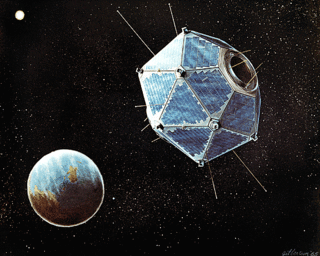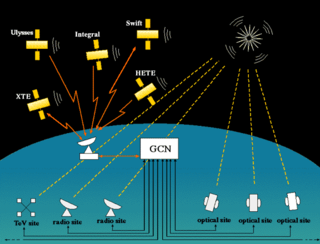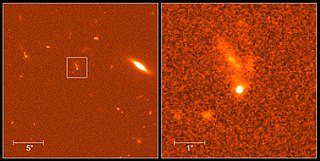
In gamma-ray astronomy, gamma-ray bursts (GRBs) are immensely energetic explosions that have been observed in distant galaxies, described by NASA as "the most powerful class of explosions in the universe". They are the most energetic and luminous electromagnetic events since the Big Bang. Bursts can last from ten milliseconds to several hours. After an initial flash of gamma rays, a longer-lived "afterglow" is usually emitted at longer wavelengths.

Ulysses was a robotic space probe whose primary mission was to orbit the Sun and study it at all latitudes. It was launched in 1990 and made three "fast latitude scans" of the Sun in 1994/1995, 2000/2001, and 2007/2008. In addition, the probe studied several comets. Ulysses was a joint venture of the European Space Agency (ESA) and the United States' National Aeronautics and Space Administration (NASA), under leadership of ESA with participation from Canada's National Research Council. The last day for mission operations on Ulysses was 30 June 2009.

BeppoSAX was an Italian–Dutch satellite for X-ray astronomy which played a crucial role in resolving the origin of gamma-ray bursts (GRBs), the most energetic events known in the universe. It was the first X-ray mission capable of simultaneously observing targets over more than 3 decades of energy, from 0.1 to 300 kiloelectronvolts (keV) with relatively large area, good energy resolution and imaging capabilities. BeppoSAX was a major programme of the Italian Space Agency (ASI) with the participation of the Netherlands Agency for Aerospace Programmes (NIVR). The prime contractor for the space segment was Alenia while Nuova Telespazio led the development of the ground segment. Most of the scientific instruments were developed by the Italian National Research Council (CNR) while the Wide Field Cameras were developed by the Netherlands Institute for Space Research (SRON) and the LECS was developed by the astrophysics division of the European Space Agency's ESTEC facility.

The Fermi Gamma-ray Space Telescope, formerly called the Gamma-ray Large Area Space Telescope (GLAST), is a space observatory being used to perform gamma-ray astronomy observations from low Earth orbit. Its main instrument is the Large Area Telescope (LAT), with which astronomers mostly intend to perform an all-sky survey studying astrophysical and cosmological phenomena such as active galactic nuclei, pulsars, other high-energy sources and dark matter. Another instrument aboard Fermi, the Gamma-ray Burst Monitor, is being used to study gamma-ray bursts and solar flares.

The Compton Gamma Ray Observatory (CGRO) was a space observatory detecting photons with energies from 20 keV to 30 GeV, in Earth orbit from 1991 to 2000. The observatory featured four main telescopes in one spacecraft, covering X-rays and gamma rays, including various specialized sub-instruments and detectors. Following 14 years of effort, the observatory was launched from Space Shuttle Atlantis during STS-37 on April 5, 1991, and operated until its deorbit on June 4, 2000. It was deployed in low Earth orbit at 450 km (280 mi) to avoid the Van Allen radiation belt. It was the heaviest astrophysical payload ever flown at that time at 16,300 kilograms (35,900 lb).

The Venera 11 was a Soviet uncrewed space mission which was part of the Venera program to explore the planet Venus. Venera 11 was launched on 9 September 1978 at 03:25:39 UTC.

The Venera 12 was an uncrewed Soviet space mission designed to explore the planet Venus. Venera 12 was launched on 14 September 1978 at 02:25:13 UTC.

Vela was the name of a group of satellites developed as the Vela Hotel element of Project Vela by the United States to detect nuclear detonations and monitor Soviet Union compliance with the 1963 Partial Test Ban Treaty.

Reuven Ramaty High Energy Solar Spectroscopic Imager was a NASA solar flare observatory. It was the sixth mission in the Small Explorer program (SMEX), selected in October 1997 and launched on 5 February 2002, at 20:58:12 UTC. Its primary mission was to explore the physics of particle acceleration and energy release in solar flares.

Neil Gehrels Swift Observatory, previously called the Swift Gamma-Ray Burst Explorer, is a NASA three-telescope space observatory for studying gamma-ray bursts (GRBs) and monitoring the afterglow in X-ray, and UV/Visible light at the location of a burst. It was launched on 20 November 2004, aboard a Delta II launch vehicle. Headed by principal investigator Neil Gehrels until his death in February 2017, the mission was developed in a joint partnership between Goddard Space Flight Center (GSFC) and an international consortium from the United States, United Kingdom, and Italy. The mission is operated by Pennsylvania State University as part of NASA's Medium Explorer program (MIDEX).

The General Coordinates Network (GCN), formerly known as the Gamma-ray burst Coordinates Network, is an open-source platform created by NASA to receive and transmit alerts about astronomical transient phenomena. This includes neutrino detections by observatories such as IceCube or Super-Kamiokande, gravitational wave events from the LIGO, Virgo and KAGRA interferometers, and gamma-ray bursts observed by Fermi, Swift or INTEGRAL. One of the main goals is to allow for follow-up observations of an event by other observatories, in hope to observe multi-messenger events.

High Energy Transient Explorer 2 was a NASA astronomical satellite with international participation. The satellite bus for the first HETE-1 was designed and built by AeroAstro, Inc. of Herndon, Virginia and was lost during launch on 4 November 1996; the replacement satellite, HETE-2 was built by Massachusetts Institute of Technology (MIT) based on the original HETE design.
SGR 0526−66 is a soft gamma repeater (SGR), located in the Super-Nova Remnant (SNR) 0526−66.1, otherwise known as N49, in the Large Magellanic Cloud. It was the first soft gamma repeater discovered, and as of 2015, the only known located outside our galaxy. First detected in March 1979, it was located by using the measurement of the arrival time differences of the signal by the set of artificial satellites equipped with gamma ray detectors. The association with N49 can only be indirect: it seems clear that soft gamma repeaters form in young stellar clusters. It is not certain that the explosion that gave birth to SGR 0525-66 is also the one that produced the remnant N49.
The history of gamma-ray began with the serendipitous detection of a gamma-ray burst (GRB) on July 2, 1967, by the U.S. Vela satellites. After these satellites detected fifteen other GRBs, Ray Klebesadel of the Los Alamos National Laboratory published the first paper on the subject, Observations of Gamma-Ray Bursts of Cosmic Origin. As more and more research was done on these mysterious events, hundreds of models were developed in an attempt to explain their origins.

GRB 990123 is a gamma-ray burst which was detected on January 23, 1999. It was the first GRB for which a simultaneous optical flash was detected. Astronomers first managed to obtain a visible-light image of a GRB as it occurred on January 23, 1999, using the ROTSE-I telescope in Los Alamos, New Mexico. The ROTSE-I was operated by a team under Dr. Carl W. Akerlof of the University of Michigan and included members from Los Alamos National Laboratory and Lawrence Livermore National Laboratory. The robotic telescope was fully automated, responding to signals from NASA's BATSE instrument aboard the Compton Gamma Ray Observatory within seconds, without human intervention. In the dark hours of the morning of January 23, 1999, the Compton satellite recorded a gamma-ray burst that lasted for about a minute and a half. There was a peak of gamma and X-ray emission 25 seconds after the event was first detected, followed by a somewhat smaller peak 40 seconds after the beginning of the event. The emission then fizzled out in a series of small peaks over the next 50 seconds, and eight minutes after the event had faded to a hundredth of its maximum brightness. The burst was so strong that it ranked in the top 2% of all bursts detected.

Gamma-ray astronomy is the astronomical observation of gamma rays, the most energetic form of electromagnetic radiation, with photon energies above 100 keV. Radiation below 100 keV is classified as X-rays and is the subject of X-ray astronomy.
GRB 000131 was a gamma-ray burst (GRB) that was detected on 31 January 2000 at 14:59 UTC. A gamma-ray burst is a highly luminous flash associated with an explosion in a distant galaxy and producing gamma rays, the most energetic form of electromagnetic radiation, and often followed by a longer-lived "afterglow" emitted at longer wavelengths.
GRB 790305b is an event that took place on 5 March 1979. It was an extremely bright burst that was successfully localized to supernova remnant N49 in the Large Magellanic Cloud. This event is now interpreted as a magnetar giant flare, more related to SGR flares than "true" gamma-ray bursts. It is the first observed SGR megaflare, a specific type of short GRB. It has been associated with the magnetar PSR B0525-66.
The Space Variable Objects Monitor (SVOM) is a planned small X-ray telescope satellite under development by China National Space Administration (CNSA), Chinese Academy of Sciences (CAS) and the French Space Agency (CNES), to be launched in March 2024.













